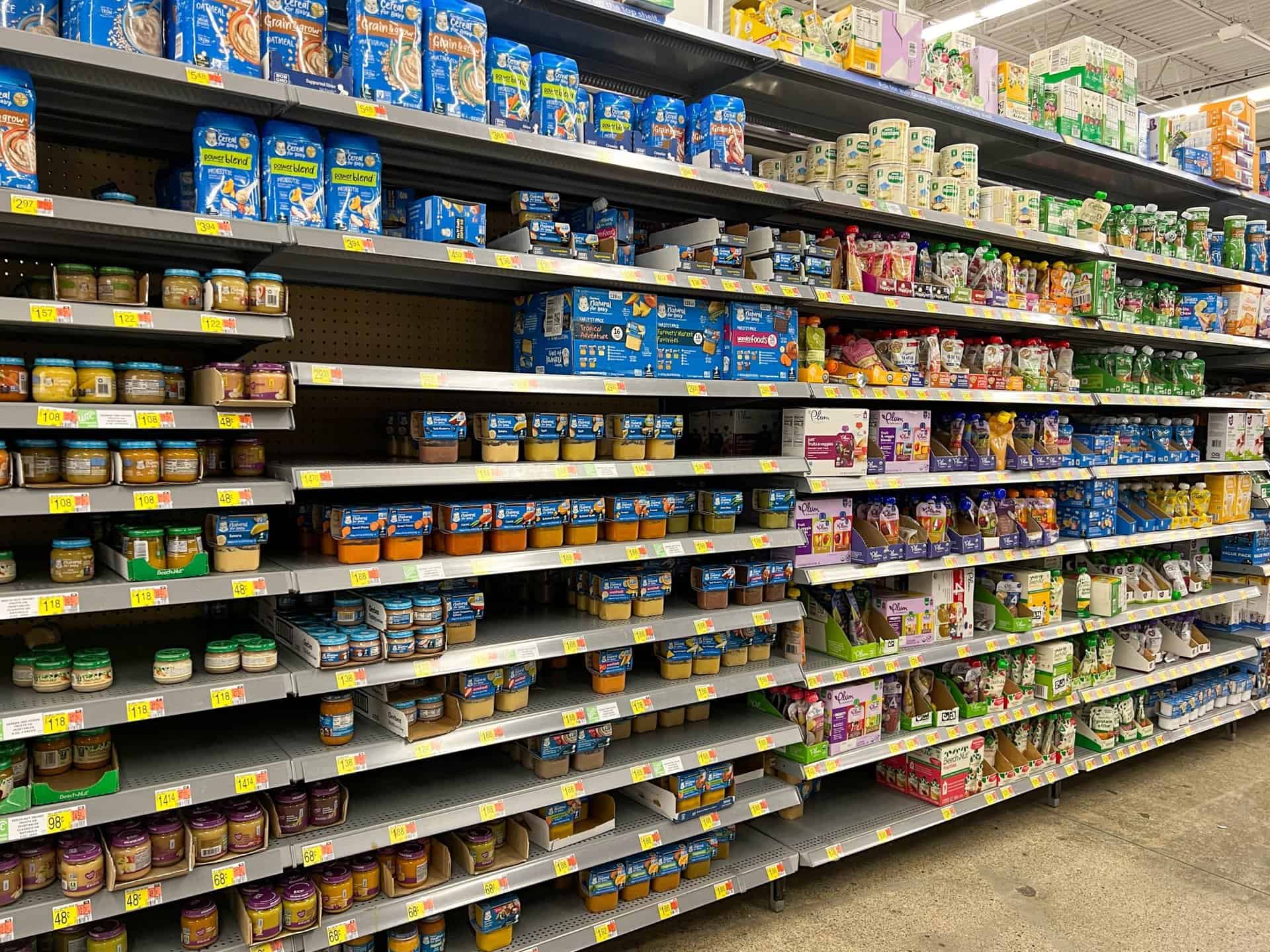Beech-Nut Nutrition Legal Battle Over Toxic Baby Food
- Last Updated: June 12th, 2025

Attorney Jessica Paluch-Hoerman, founder of TruLaw, has over 28 years of experience as a personal injury and mass tort attorney, and previously worked as an international tax attorney at Deloitte. Jessie collaborates with attorneys nationwide — enabling her to share reliable, up-to-date legal information with our readers.
Legally Reviewed
This article has been written and reviewed for legal accuracy and clarity by the team of writers and legal experts at TruLaw and is as accurate as possible. This content should not be taken as legal advice from an attorney. If you would like to learn more about our owner and experienced injury lawyer, Jessie Paluch, you can do so here.
Fact-Checked
TruLaw does everything possible to make sure the information in this article is up to date and accurate. If you need specific legal advice about your case, contact us by using the chat on the bottom of this page. This article should not be taken as advice from an attorney.
Key takeaways:
- Beech-Nut Nutrition Company has faced legal battles and public scrutiny over allegations of unsafe levels of toxic heavy metals like lead, arsenic, cadmium, and mercury in their baby food products.
- The baby food industry lacks strict federal standards for toxic heavy metals, leading to lawsuits, government investigations, and calls for more stringent regulations and testing to ensure the safety of baby food products and rebuild consumer trust.
- In response to the toxic baby food crisis, companies like Beech-Nut are implementing mitigation strategies such as enhanced screening protocols, supplier audits, transparent labeling, and investing in research to ensure safer baby food production.
Overview of Toxic Baby Food
On this page, we’ll discuss an overview of toxic baby food, health risks associated with toxic baby food ingredients, Beech-Nut Nutrition’s involvement in the toxic baby food lawsuit, and much more.
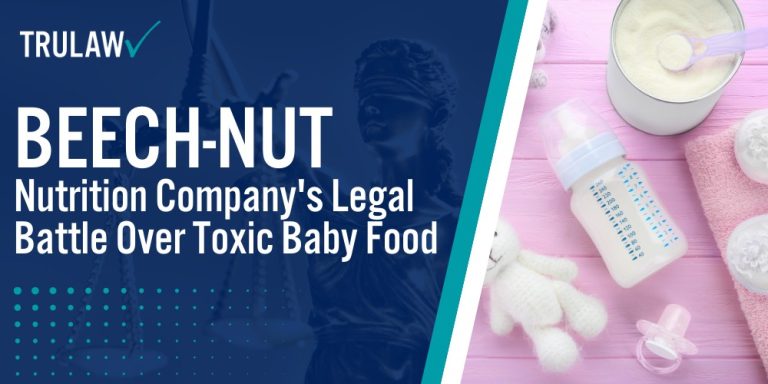
Intro to Beech-Nut Nutrition: Toxic Baby Food
Key aspects of toxic baby food include, but are not limited to:
- Heavy Metal Contamination: Many baby foods contain harmful levels of heavy metals like lead, arsenic, cadmium, and mercury, which can pose serious health risks to infants.
- Developmental Delays: Exposure to toxic substances in baby food can lead to impaired cognitive development, behavioral issues, and lower IQ scores in children.
- Lack of Regulation: Despite the known risks, there are currently no federal standards for toxic heavy metals in baby foods, leaving the industry largely self-regulated.
- Legal Action: Companies like Beech-Nut Nutrition have faced lawsuits and government scrutiny over allegations of unsafe levels of toxic metals in their baby food products.
If your child has suffered health issues or developmental delays after consuming toxic baby food, you may be eligible for compensation.
Contact Tru Law using the chat on this page to receive an instant case evaluation and determine if you qualify to file a toxic baby food lawsuit.
Table of Contents
Understanding the Impact of Toxic Baby Food
Toxic baby food can pose significant health risks to infants due to the presence of harmful chemicals and heavy metals.
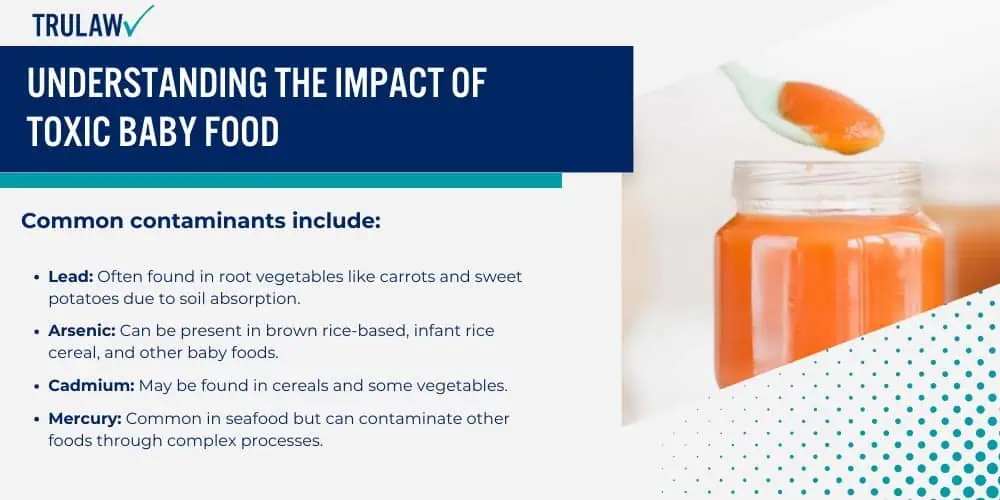
Health impacts on infants include impaired cognitive development and lower IQ.
Parents must know these risks and consider alternative baby foods with lower contamination levels.
More stringent regulations and routine testing could help mitigate these concerns.
What Constitutes Toxic Baby Food? Key Ingredients
Certain baby foods can contain heavy metals like lead, arsenic, cadmium, and mercury.
These substances are often found in popular baby foods such as sweet potatoes and carrots.
Heavy metal contamination can result from various factors, including soil exposure and manufacturing processes.
Common contaminants include:
- Lead: Often found in root vegetables like carrots and sweet potatoes due to soil absorption.
- Arsenic: Can be present in brown rice-based, infant rice cereal, and other baby foods.
- Cadmium: May be found in cereals and some vegetables.
- Mercury: Common in seafood but can contaminate other foods through complex processes.
Limiting exposure to these harmful elements can minimize the risks associated with toxic baby food.
Health Risks Associated with Toxic Baby Food
Exposure to heavy metals and harmful chemicals in baby food can lead to several health issues.
Infants are particularly vulnerable due to their developing systems and higher food intake relative to their body weight.
Possible health risks associated with toxic baby food include:
- Developmental Delays: Lead exposure can impair cognitive and behavioral development.
- Organ Damage: Arsenic and mercury can cause liver and kidney issues.
- Bone and Teeth Issues: Cadmium exposure may affect bone growth and dental health.
- Impaired Immune Function: Heavy metals can weaken a child’s immune system.
Caregivers should be aware of these risks and select baby foods carefully to ensure their child’s health and safety.
Beech-Nut Nutrition Company and Toxic Baby Food
Beech-Nut Nutrition Company has faced significant scrutiny due to allegations of toxic substances in their baby food products.
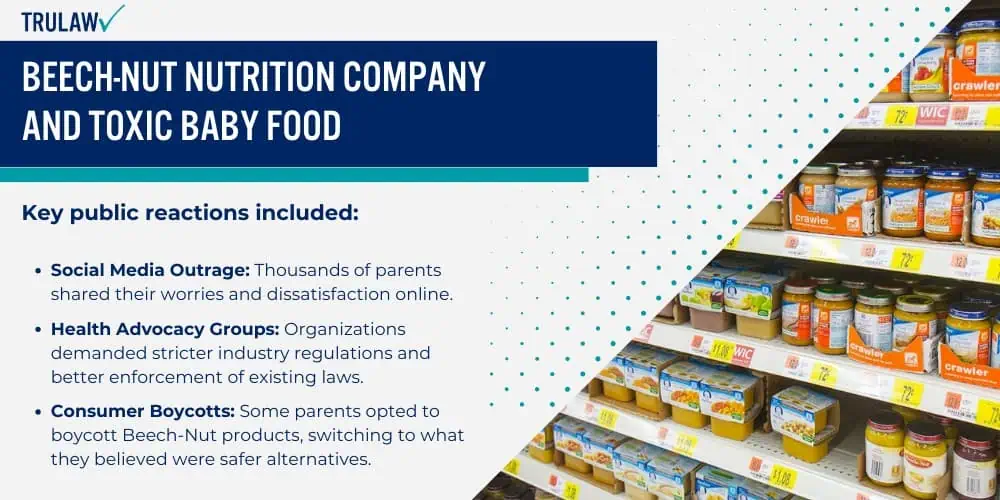
These issues have led to considerable public backlash and raised questions about industry standards and regulations.
Beech-Nut’s Involvement in the Toxic Baby Food Scandal
Beech-Nut Nutrition Company was implicated in a scandal involving toxic substances found in their baby food products.
Studies and reports indicated the presence of harmful levels of heavy metals like arsenic, lead, and cadmium in various products.
The Food and Drug Administration (FDA) highlighted several concerns about these contaminants.
Many of these toxic materials can have severe health impacts on infants and toddlers, who are particularly susceptible due to their developing bodies.
In response, Beech-Nut issued statements claiming it was committed to meeting safety standards and continually testing its products for harmful substances.
Despite these assurances, the controversy persisted, prompting widespread concern among parents and healthcare professionals.
Public Reactions to Beech-Nut’s Toxic Baby Food
The revelation of toxic substances in Beech-Nut’s baby food sparked significant public concern.
Many parents expressed fear and anger on social media, calling for more stringent regulations and transparency from baby food manufacturers.
Key public reactions included:
- Social Media Outrage: Thousands of parents shared their worries and dissatisfaction online.
- Health Advocacy Groups: Organizations demanded stricter industry regulations and better enforcement of existing laws.
- Consumer Boycotts: Some parents opted to boycott Beech-Nut products, switching to what they believed were safer alternatives.
- Governmental Scrutiny: Increased pressure on regulatory bodies to monitor and regulate the baby food aisle more stringently.
These reactions underscore the growing demand for safer and more transparent practices in the baby food industry.
The situation highlighted the need for manufacturers like Beech-Nut to rebuild trust and ensure the highest safety standards.
Legal Actions Against Beech-Nut Nutrition Company
Beech-Nut Nutrition Company has faced multiple legal challenges concerning toxic substances in its baby food products.
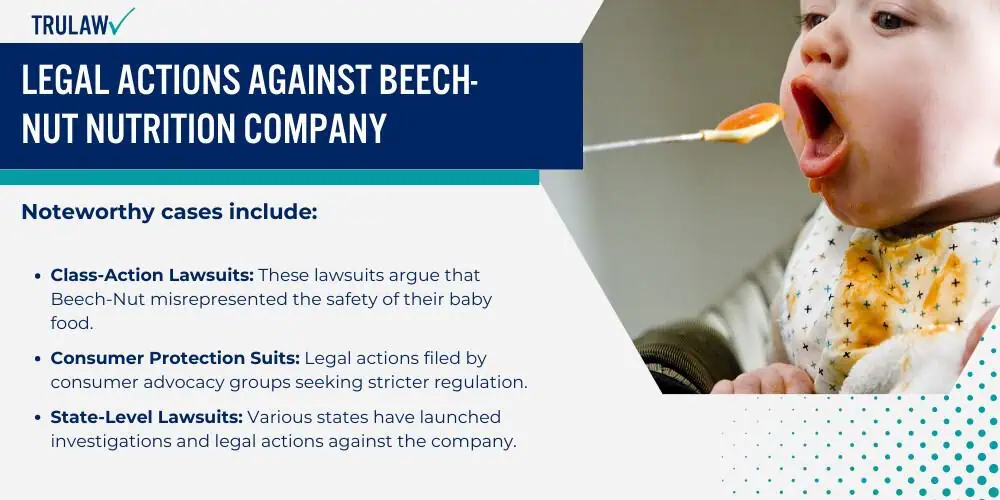
These actions often highlight issues relating to economic and consumer policy, drawing attention to health risks and regulatory oversights.
Major Lawsuits Filed Over Toxic Baby Food
Beech-Nut has encountered significant legal scrutiny due to allegations of toxic heavy metals in their baby food products.
Multiple lawsuits claim that the company failed to meet health and safety standards, potentially endangering infants’ well-being.
Noteworthy cases include:
- Class-Action Lawsuits: These lawsuits argue that Beech-Nut misrepresented the safety of their baby food.
- Consumer Protection Suits: Legal actions filed by consumer advocacy groups seeking stricter regulation.
- State-Level Lawsuits: Various states have launched investigations and legal actions against the company.
- Federal Scrutiny: Reports suggest potential federal investigations into regulatory compliance.
Key Legal Developments in Beech-Nut’s Legal Battle
Several important developments have emerged from Beech-Nut’s legal battles.
These cases highlight the complexity and the ongoing nature of regulatory and legal challenges in the baby food industry.
Significant developments include:
- Court Settlements: Some lawsuits resulted in settlements requiring the company to change labeling practices.
- Regulatory Updates: Legal actions sparked changes in food safety regulations at both state and federal levels.
- Corporate Responses: Beech-Nut’s statements emphasize their commitment to improving safety standards.
- Economic Impacts: The legal battles have financially affected Beech-Nut, impacting its market position and consumer trust.
- Policy Reform: Legal pressures have influenced broader policy discussions on food safety standards for infant foods.
Regulatory and Industry Responses to Toxic Baby Food
Efforts to address the issue of toxic baby food include government regulations and industry reactions.
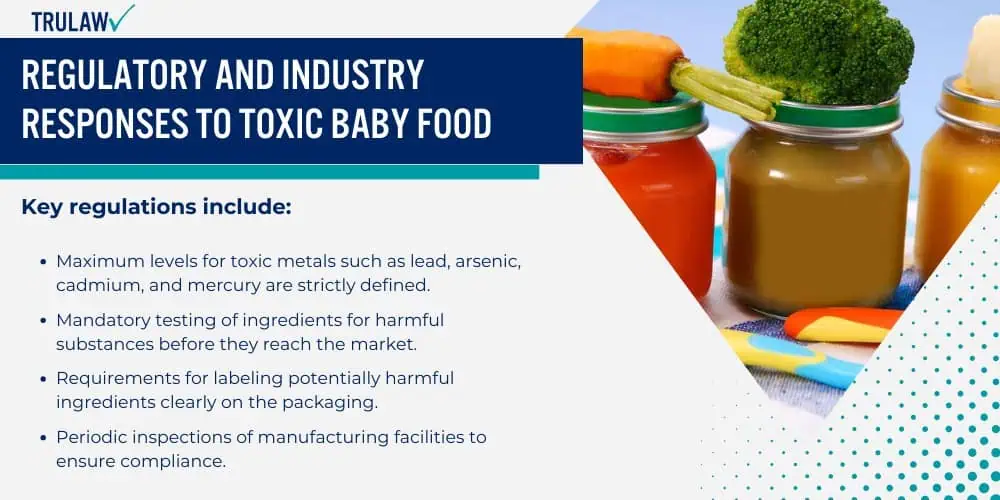
Regulatory bodies have enacted legislation to limit harmful substances, while the food industry has responded with its own measures to ensure product safety.
Government Regulations on Toxic Baby Food Ingredients
Government agencies have taken significant steps to regulate toxic substances in baby food.
The U.S. Food and Drug Administration (FDA) and the European Union (EU) have implemented standards manufacturers must follow.
Key regulations include:
- Maximum levels for toxic metals such as lead, arsenic, cadmium, and mercury are strictly defined.
- Mandatory testing of ingredients for harmful substances before they reach the market.
- Requirements for labeling potentially harmful ingredients clearly on the packaging.
- Periodic inspections of manufacturing facilities to ensure compliance.
These measures aim to reduce toxic metal exposure in infants, ensuring safer food supplies.
Industry-Wide Reactions to Toxic Baby Food Concerns
The food industry has proactively responded to consumer concerns about toxic substances in baby food.
Key industry responses include:
- Reformulating products to eliminate or reduce toxic metals.
- Investing in advanced testing technologies to detect contaminants more effectively.
- Establishing partnerships with independent labs for unbiased safety testing.
- Launching awareness campaigns to educate consumers on safety measures taken.
Manufacturers of infant formula and baby food are committed to improving safety standards and striving for healthier products.
These steps are part of a collaborative effort to address and mitigate toxic baby food concerns.
Consumer Advocacy and Awareness of Toxic Baby Food
Consumers are becoming more vigilant about the presence of toxic elements in baby food.
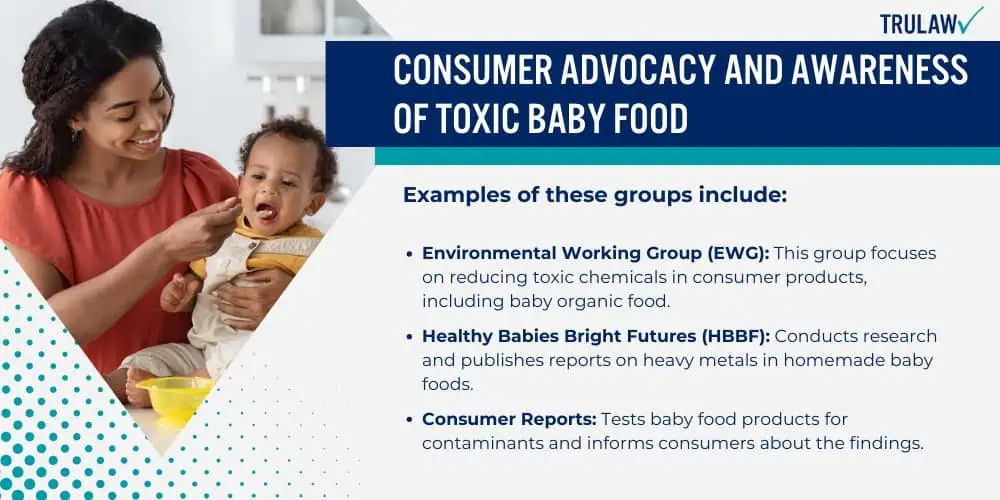
Advocacy groups and educational efforts to inform parents and caregivers about potential risks drive this awareness.
Advocacy Groups Addressing Toxic Baby Food Risks
Advocacy groups have played an important role in raising awareness about harmful chemicals in baby food.
These organizations work diligently to protect babies’ health by campaigning for stricter regulations and more transparent labeling.
Examples of these groups include:
- Environmental Working Group (EWG): This group focuses on reducing toxic chemicals in consumer products, including baby organic food.
- Healthy Babies Bright Futures (HBBF): Conducts research and publishes reports on heavy metals in homemade baby foods.
- Consumer Reports: Tests baby food products for contaminants and informs consumers about the findings.
- Non-Governmental Organizations (NGOs): Advocate for policy changes to ensure safer products for infants.
These groups often collaborate with scientific researchers to gather data and influence policy changes through public campaigns and lobbying efforts.
Educating Parents About Toxic Baby Food Dangers
Educating parents about the potential risks associated with toxic elements in baby food is essential to safeguarding babies’ health.
Information dissemination can take multiple forms, from online resources to community workshops.
Effective methods to educate parents include:
- Online Resources: Websites and social media platforms that provide up-to-date information and resources.
- Community Workshops: Local events where parents can learn directly from experts.
- Healthcare Providers: Pediatricians and healthcare providers offering advice during routine check-ups.
- Public Awareness Campaigns: Brochures, posters, and public service announcements detailing the risks and preventive measures.
- Educational Tools: Apps and guides that help parents make informed choices when purchasing baby food.
Parents and caregivers can better protect their infants from harmful substances commonly found in baby foods by staying informed.
Beech-Nut's Mitigation Strategies for Toxic Baby Food
Beech-Nut has implemented several measures to address and reduce the risk of toxic substances in baby food.
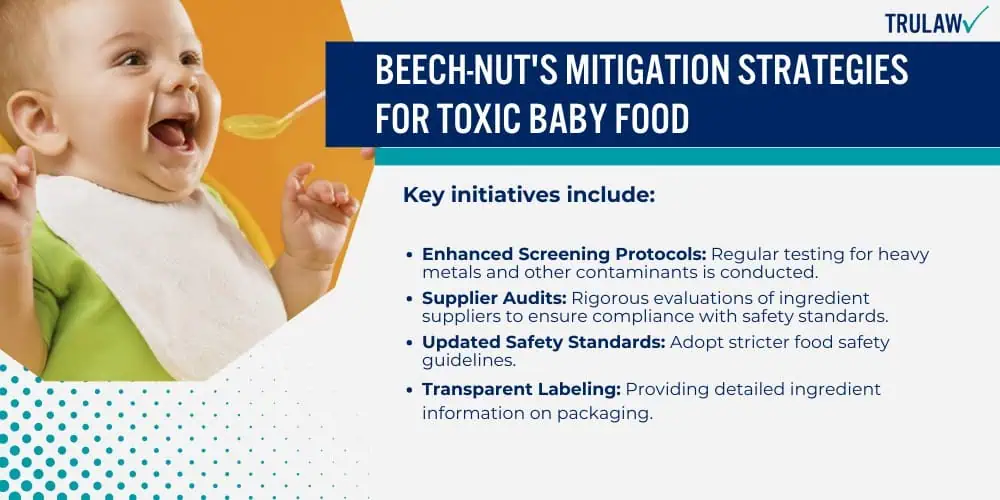
These efforts include adopting best practices for product safety and specific steps to rectify past issues related to contaminants.
Best Practices for Ensuring Safe Baby Food Products
Beech-Nut employs several strategies to safeguard its own baby food products.
Key initiatives include:
- Enhanced Screening Protocols: Regular testing for heavy metals and other contaminants is conducted.
- Supplier Audits: Rigorous evaluations of ingredient suppliers to ensure compliance with safety standards.
- Updated Safety Standards: Adopt stricter food safety guidelines.
- Transparent Labeling: Providing detailed ingredient information on packaging.
- Consumer Education Programs: Informing parents about safe food handling and preparation.
These initiatives are essential in maintaining consumers’ trust and ensuring their products’ overall safety.
A top priority is ensuring that rice cakes-based teething biscuits and other solid foods are safe.
Steps Beech-Nut is Taking to Resolve Toxic Food Issues
Beech-Nut has taken significant steps to mitigate these risks in response to concerns about toxic substances in baby food.
Actions include:
- Recalls: Initiating product recalls when contaminants are detected.
- Collaboration with Experts: Working closely with food safety experts to develop better processes.
- Investment in Research: Funding studies to understand and eliminate sources of contamination.
- Sourcing Safer Ingredients: Prioritizing organic and non-contaminated raw materials.
- Quality Control Improvements: Upgrading manufacturing processes to minimize contamination risks.
By implementing these steps, Beech-Nut aims to ensure that not only baby food but all store-bought baby food products from its brand are safe for consumption.
Future Implications and Industry Changes Post-Lawsuit
The legal challenges faced by baby food companies have significant consequences for the industry.
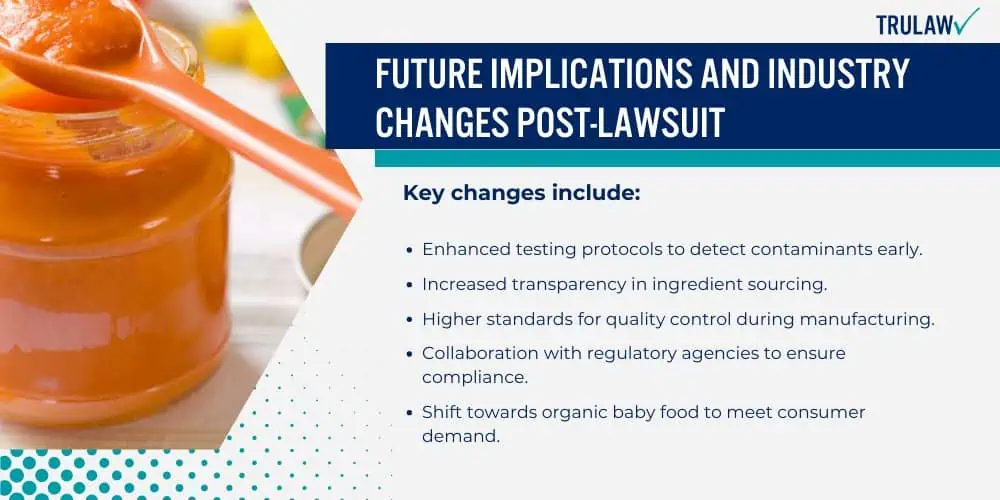
There are shifts in regulatory practices and production processes aimed at ensuring the safety of baby food.
Long-Term Impact of Beech-Nut’s Legal Battle on the Industry
The lawsuit involving Beech-Nut has prompted a re-evaluation within the baby food industry.
Companies are bolstering their safety protocols and adopting stricter regulatory compliance measures.
Key changes include:
- Enhanced testing protocols to detect contaminants early.
- Increased transparency in ingredient sourcing.
- Higher standards for quality control during manufacturing.
- Collaboration with regulatory agencies to ensure compliance.
- Shift towards organic baby food to meet consumer demand.
- More investments in research and development for safer products.
Moving Forward: Ensuring Safety in Baby Food Production
In the wake of the lawsuit, baby food producers are avoiding similar issues.
This involves implementing comprehensive safety measures and improving product quality.
These measures include:
- Adoption of advanced technologies for detecting harmful substances.
- Regular training for employees on safety standards.
- Commitment to using organic and non-GMO ingredients.
- Rigorous auditing processes to maintain high safety standards.
- Partnerships with food safety experts for better oversight.
- Encouraging homemade baby food options among parents for higher safety and confidence.
By implementing these steps, companies aim to regain consumer trust and ensure the highest standards of baby food safety.
TruLaw: Addressing the Toxic Baby Food Crisis
TruLaw addresses the public’s concerns regarding toxic substances in baby food by advocating for enhanced safety standards and legal accountability for manufacturers.
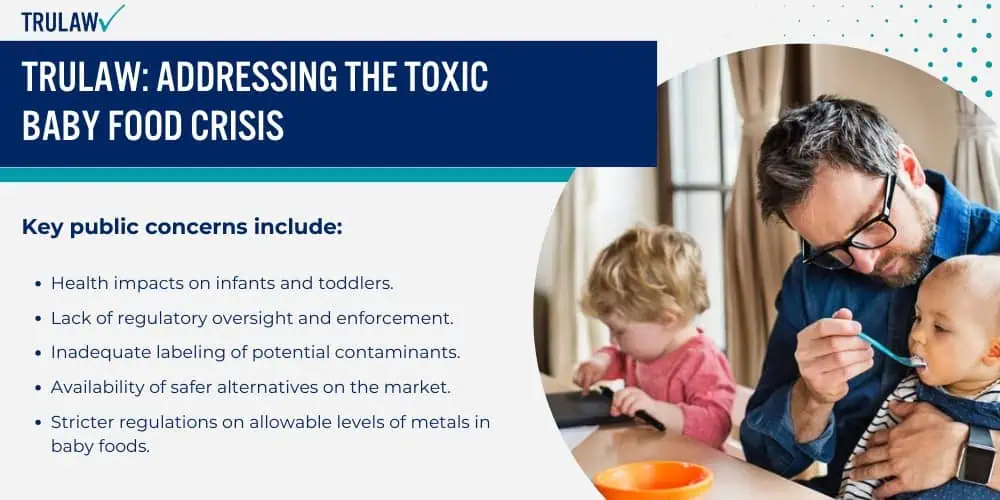
Public Concerns and Safety Measures Moving Forward
Widespread reports about metals in baby foods such as lead, arsenic, mercury, and cadmium have raised significant alarms.
Key public concerns include:
- Health impacts on infants and toddlers.
- Lack of regulatory oversight and enforcement.
- Inadequate labeling of potential contaminants.
- Availability of safer alternatives on the market.
- Stricter regulations on allowable levels of metals in baby foods.
- Enhanced testing protocols before products reach shelves.
- Transparency from manufacturers about ingredients and potential contaminants.
- Increased public awareness campaigns led by health organizations.
Implementing these safety measures can mitigate risks and protect children’s health more effectively.
These toxic substances have been detected in various baby food products, including those made from green beans and fresh carrots.
Toxic Baby Food Lawsuit Frequently Asked Questions
-
What are the key allegations against Beech-Nut Nutrition Company regarding their baby food products?
Beech-Nut Nutrition Company has been accused of using baby food products containing unsafe levels of toxic heavy metals like lead, arsenic, cadmium, and mercury.
These allegations have led to lawsuits, government investigations, and calls for stricter regulations in the baby food industry.
-
What are the potential health risks associated with toxic substances in baby food?
Exposure to toxic substances in baby food can lead to impaired cognitive development, behavioral issues, and lower IQ scores in children.
Infants are particularly vulnerable due to their developing systems and higher food intake relative to their body weight.
-
How has the public reacted to the revelation of toxic substances in Beech-Nut's baby food?
The public has expressed significant concern and outrage over the presence of toxic substances in Beech-Nut’s baby food, with reactions including social media outrage, calls for stricter regulations, consumer boycotts, and increased governmental scrutiny.
These reactions underscore the growing demand for safer and more transparent practices in the baby food industry.
-
What steps is Beech-Nut taking to address the issue of toxic substances in their baby food products?
Beech-Nut is implementing several mitigation strategies, such as enhanced screening protocols, supplier audits, updated safety standards, transparent labeling, and investment in research.
These efforts aim to ensure safer baby food production and rebuild consumer trust.
-
What can parents do to protect their children from the risks associated with toxic baby food?
Parents can take steps to protect their children by staying informed about potential risks, choosing baby food products carefully, and advocating for stricter regulations and transparency from manufacturers.
Parents can make informed decisions about selecting baby food products by educating themselves through online resources, community workshops, and advice from healthcare providers.

Managing Attorney & Owner
With over 25 years of legal experience, Jessica Paluch-Hoerman is an Illinois lawyer, a CPA, and a mother of three. She spent the first decade of her career working as an international tax attorney at Deloitte.
In 2009, Jessie co-founded her own law firm with her husband – which has scaled to over 30 employees since its conception.
In 2016, Jessie founded TruLaw, which allows her to collaborate with attorneys and legal experts across the United States on a daily basis. This hypervaluable network of experts is what enables her to share the most reliable, accurate, and up-to-date legal information with our readers!
Additional Toxic Baby Food Lawsuit resources on our website:
Here, at TruLaw, we’re committed to helping victims get the justice they deserve.
Alongside our partner law firms, we have successfully collected over $3 Billion in verdicts and settlements on behalf of injured individuals.
Would you like our help?
At TruLaw, we fiercely combat corporations that endanger individuals’ well-being. If you’ve suffered injuries and believe these well-funded entities should be held accountable, we’re here for you.
With TruLaw, you gain access to successful and seasoned lawyers who maximize your chances of success. Our lawyers invest in you—they do not receive a dime until your lawsuit reaches a successful resolution!
AFFF Lawsuit claims are being filed against manufacturers of aqueous film-forming foam (AFFF), commonly used in firefighting.
Claims allege that companies such as 3M, DuPont, and Tyco Fire Products failed to adequately warn users about the potential dangers of AFFF exposure — including increased risks of various cancers and diseases.
Depo Provera Lawsuit claims are being filed by individuals who allege they developed meningioma (a type of brain tumor) after receiving Depo-Provera birth control injections.
A 2024 study found that women using Depo-Provera for at least 1 year are five times more likely to develop meningioma brain tumors compared to those not using the drug.
Suboxone Tooth Decay Lawsuit claims are being filed against Indivior, the manufacturer of Suboxone, a medication used to treat opioid addiction.
Claims allege that Indivior failed to adequately warn users about the potential dangers of severe tooth decay and dental injuries associated with Suboxone’s sublingual film version.
Social Media Harm Lawsuits are being filed against social media companies for allegedly causing mental health issues in children and teens.
Claims allege that companies like Meta, Google, ByteDance, and Snap designed addictive platforms that led to anxiety, depression, and other mental health issues without adequately warning users or parents.
Transvaginal Mesh Lawsuits are being filed against manufacturers of transvaginal mesh products used to treat pelvic organ prolapse (POP) and stress urinary incontinence (SUI).
Claims allege that companies like Ethicon, C.R. Bard, and Boston Scientific failed to adequately warn about potential dangers — including erosion, pain, and infection.
Bair Hugger Warming Blanket Lawsuits involve claims against 3M — alleging their surgical warming blankets caused severe infections and complications (particularly in hip and knee replacement surgeries).
Plaintiffs claim 3M failed to warn about potential risks — despite knowing about increased risk of deep joint infections since 2011.
Baby Formula NEC Lawsuit claims are being filed against manufacturers of cow’s milk-based baby formula products.
Claims allege that companies like Abbott Laboratories (Similac) and Mead Johnson & Company (Enfamil) failed to warn about the increased risk of necrotizing enterocolitis (NEC) in premature infants.
Here, at TruLaw, we’re committed to helping victims get the justice they deserve.
Alongside our partner law firms, we have successfully collected over $3 Billion in verdicts and settlements on behalf of injured individuals.
Would you like our help?
